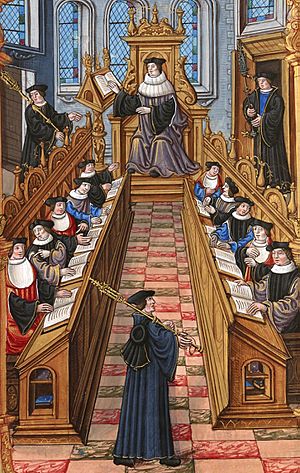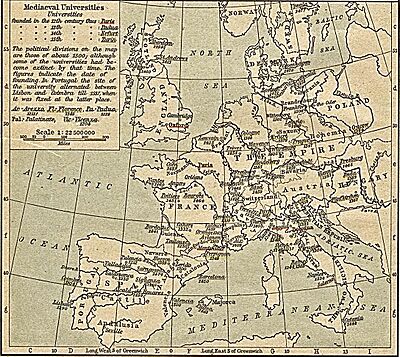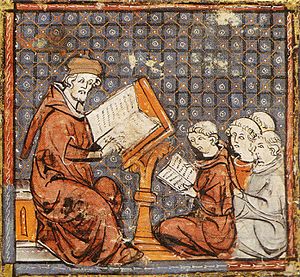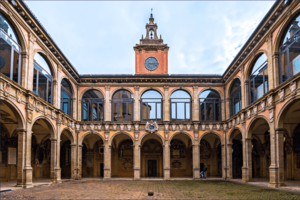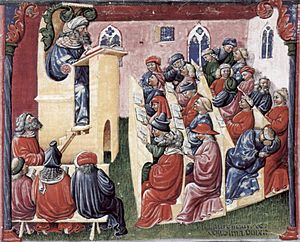Medieval university facts for kids
A medieval university was a special group, like a club or a guild, formed during the Middle Ages. Its main goal was to provide higher education to students. The very first universities in Western Europe appeared in places like Italy, England, France, Spain, Portugal, and Scotland. This happened between the 11th and 15th centuries. Students there could study the arts, and also advanced subjects like theology (the study of religion), law, and medicine.
These early universities grew out of older Christian cathedral schools and monastic schools. It's hard to say exactly when they became "true" universities. The word universitas originally meant the group of students and teachers within a school. It was like saying "the community of masters" or "the community of scholars." Later, around the late 1300s, the word "university" by itself came to mean a self-governing group of teachers and students. This group was officially recognized by rulers or church leaders.
Over time, this type of university, which started in Western Europe, spread across the world. It became the main way people got higher education everywhere.
Contents
How Universities Started
Most people see the university as a formal place of learning that began in the Christian Middle Ages. For hundreds of years before universities, higher education in Europe happened in Christian cathedral schools and monastic schools. Here, monks and nuns taught classes. Records show these schools existed as early as the 6th century AD.
As European towns grew in the 1100s and 1200s, there was a need for more professional clergy (church officials). After the Gregorian Reform focused on church law and religious practices, bishops started cathedral schools. These schools trained clergy in church law and other skills needed for church work. This included logic for discussions and accounting for managing money. Pope Gregory VII helped a lot by ordering the creation of these cathedral schools in 1079. Many of these schools later turned into the first European universities.
Learning became very important for moving up in the church. Teachers also gained respect. Soon, the cathedral schools, each run by one schoolmaster, couldn't handle all the students. Also, there were often arguments between students and local citizens in smaller towns. Because of this, cathedral schools moved to bigger cities like Bologna, Rome, and Paris.
Some historians have suggested that early European universities might have been influenced by madrasahs (Islamic schools) in places like Islamic Spain. However, other historians disagree. They point out that there isn't enough proof of this connection. They also highlight many differences in how these schools were set up and what they taught.
Creating New Universities
Historian Hastings Rashdall explained that the first universities often started on their own. They were like a "scholastic Guild" (a group of scholars), either of masters or students. They didn't always need special permission from a king, pope, or other leader.
Some of the very first universities that started this way include:
- University of Bologna (1088)
- University of Paris (around 1150)
- University of Oxford (1167)
- University of Cambridge (1209)
- University of Salamanca (1218)
- University of Padua (1222)
- University of Naples (1224)
- Charles University in Prague (1348)
- Jagiellonian University (1364)
- University of Vienna (1365)
- Heidelberg University (1386)
These began as private groups of teachers and their students.
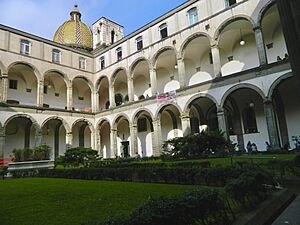
Often, universities asked rulers for special rights. This became a common practice. Emperor Frederick I gave the first special rights to students in Bologna in 1158. Another important step was in 1179. Pope Alexander III said that church schools could not charge fees for giving permission to teach. He also said they had to give permission to qualified teachers. Rashdall believed that a university stayed strong if it was run by its own members. This protected scholars from outside interference. However, universities in southern Italy and Spain were different. They were created by kings to serve their governments.
The University of Paris was officially recognized when Pope Gregory IX issued a special order called Parens scientiarum in 1231. This was a big change. Schools and groups of students/teachers existed before. But after this order, they gained autonomy (the right to govern themselves). A papal order in 1233 said that anyone allowed to teach in Toulouse could teach anywhere without more tests. This right, called ius ubique docendi, became a key feature of universities. By 1292, even the oldest universities, Bologna and Paris, sought similar orders from the Pope.
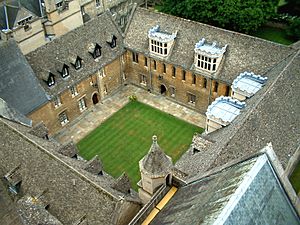
By the 1200s, almost half of the highest church positions were held by university graduates. More than a third of the next highest positions were also held by graduates. Also, some of the most famous thinkers of the High Middle Ages, like Thomas Aquinas and Robert Grosseteste, came from medieval universities.
The growth of medieval universities happened at the same time that the writings of Aristotle were widely brought back to Europe. These writings came from Byzantine and Arab scholars. In fact, European universities made Aristotle's works and other science texts central to their studies. This meant that "the medieval university focused much more on science than modern universities do."
Some people thought universities declined during the Renaissance. This was because their focus on Aristotle and old ways of thinking seemed less popular than the new cultural studies of Renaissance humanism. However, Toby Huff has shown that European universities remained important. Their focus on Aristotle and scientific texts continued into the early modern period. He argues they played a key role in the Scientific Revolution of the 1500s and 1600s. He says that famous scientists like Copernicus, Galileo, Tycho Brahe, Kepler, and Newton were all products of these universities.
University Features

At first, medieval universities didn't have their own buildings or a campus. Classes were held wherever space was free, like in churches or homes. A university was not a place, but a group of people joined together as a universitas. But soon, universities started to rent, buy, or build places just for teaching.
Universities were usually set up in three ways, depending on who paid the teachers.
- The first type was like Bologna. Here, students hired and paid the teachers themselves.
- The second type was like Paris. Here, the church paid the teachers.
- Oxford and Cambridge were mostly supported by the king and the government. This helped them survive big changes later on.
These differences led to other features. In Bologna, students ran everything. This often put teachers under a lot of pressure. In Paris, teachers ran the school. So, Paris became the top place for teachers from all over Europe. Also, in Paris, the main subject was theology. This meant an outside authority, the local church leader, controlled who could teach. In Bologna, where students chose more everyday studies, the main subject was law.
It was also common for teachers and scholars to move around. Universities often competed to get the best and most popular teachers. This made teaching a kind of market. Universities would publish lists of their scholars to attract students. Students of Peter Abelard, a famous teacher, followed him to different towns. This shows that popular teachers brought their students with them.
Students in Medieval Times
Students went to medieval universities at different ages. Some were 14 if they studied arts at Oxford or Paris. Others were in their 30s if they studied law in Bologna. During their studies, students often lived far from home without adult supervision. Because of this, they sometimes got a reputation for wild behavior and drinking. People in the Middle Ages often criticized students for not studying enough. In Bologna, some laws allowed students to become citizens of the city if they were enrolled at the university.
What Students Studied
To get a Master of Arts degree, university studies took six years. A Bachelor of Arts degree was given after the third or fourth year. These studies were organized by the faculty of arts. Here, the seven liberal arts were taught:
- arithmetic (math)
- geometry (shapes and space)
- astronomy (stars and planets)
- music theory
- grammar (language rules)
- logic (reasoning)
- rhetoric (persuasive speaking)
All teaching was in Latin, and students were expected to speak Latin. The trivium included the first three subjects taught: grammar, logic, and rhetoric. The quadrivium included arithmetic, geometry, music, and astronomy. The quadrivium was taught after the trivium and led to the Master of Arts degree. The subjects also came to include three types of Aristotle's philosophy: physics, metaphysics, and moral philosophy.
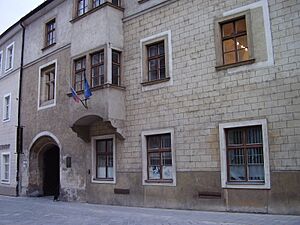
Much of medieval thinking in philosophy and theology can be found in scholastic writings. This was because scholasticism was a very popular way of teaching. For grammar, the main textbook was Aelius Donatus' Ars grammatica. Students also studied works by Priscian. For rhetoric, they used Cicero's works. Books on logic included Porphyry's introduction to Aristotle's logic. The main book for astronomy was Tractatus de sphaera.
Once a student earned a Master of Arts degree, they could leave the university. Or, they could continue their studies in one of the higher subjects: law, medicine, or theology. Theology was the most respected. At first, only a few universities had a theology department. This was because the popes wanted to control theological studies. Until the mid-1300s, theology could only be studied at universities in Paris, Oxford, Cambridge, and Rome. The founding of the University of Prague in 1347 ended this monopoly. After that, other universities also gained the right to create theology departments.
A popular textbook for theology was Sentences by Peter Lombard. Theology students and teachers had to lecture or write long comments on this text. Studies in the higher subjects could take up to twelve years for a master's degree or doctorate. (At first, these two degrees meant the same thing.) However, a bachelor's degree and a licentiate's degree could be earned along the way.
Courses were taught based on specific books, not by general subject. For example, a course might be on a book by Aristotle or a book from the Bible. Courses were not chosen by students; the offerings were set, and everyone took the same courses. However, students sometimes had a choice of which teacher to use.
Students often started university at 14 or 15 years old, though many were older. Classes usually began very early, around 5:00 or 6:00 AM.
Student Rights
Students had the legal status of clergy (church officials). This meant that Canon Law (church law) did not allow women to be admitted to universities. Students also had the legal protection of the clergy. No one was allowed to physically harm them. They could only be tried for crimes in a church court. This meant they were safe from most physical punishments. This freedom sometimes led students to break local laws without serious consequences.
This situation often caused problems with local authorities. There was a constant tension between the "town" (citizens) and the "gown" (university students and teachers). Sometimes, teachers and students would "strike" by leaving a city and not returning for years. This happened at the University of Paris strike of 1229. After a riot where several students died, the university went on strike and did not return for two years.
Most universities in Europe were recognized by the Holy See (the Pope) as studia generalia. This was confirmed by a special papal order. People from these universities were encouraged to share their knowledge across Europe. They often lectured at different studia generalia. In fact, one of the rights confirmed by the papal order was the ius ubique docendi. This was the right to teach everywhere, and it showed the university's independence.
See also
- Ancient higher-learning institutions
- Ancient universities in the UK
- Ancient universities of Scotland
- List of oldest universities in continuous operation
- Nation (university)
- Renaissance of the 12th century


